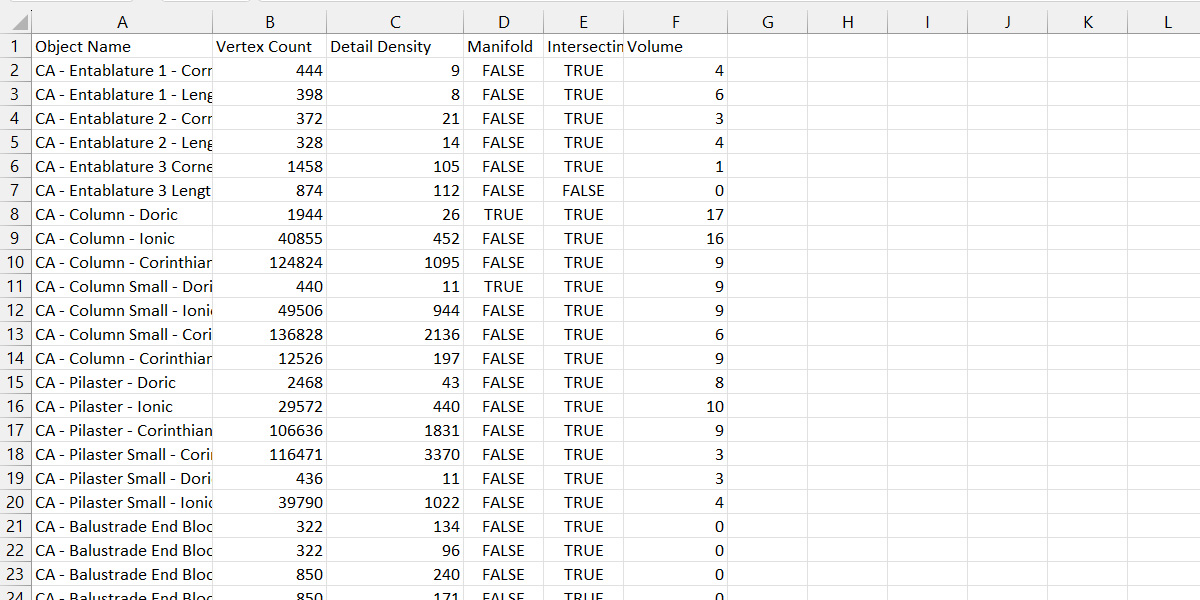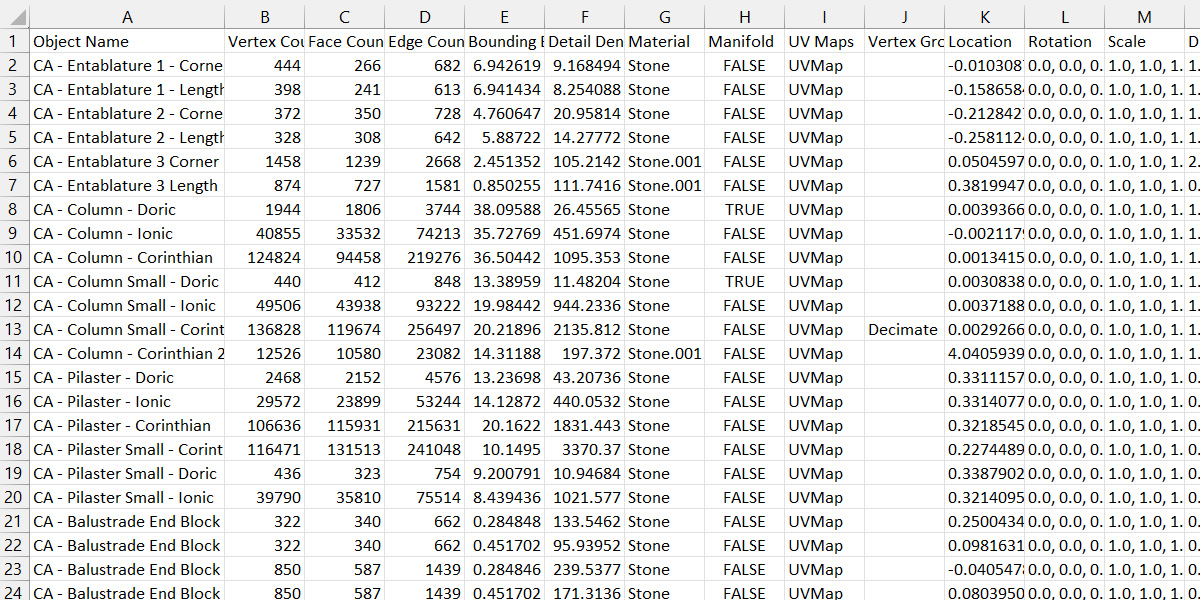Bulk Mesh Analysis Addon
Bulk Mesh Analysis
Accessible from the Export menu, Bulk Mesh Analysis is a Blender addon that allows you to export a comprehensive list of properties for mesh objects from your 3D models to a CSV file format. This addon is designed to streamline your workflow and provide valuable insights into your mesh objects for analysis, optimization, and data processing. Once you have the CSV file, it can easily be imported into any spreadsheet software like Excel, Libre Office or Google Sheet for further analysis. Make managing large scenes that little bit easier.
Update 06/04/2024: v1.1 now has option to export info on texture resolution and if textures are missing.
Use Cases:
- Model Optimization: Use the exported data to analyze and optimize your 3D models for better performance, lower polygon count, or more efficient UV layouts.
- Asset Management: Keep track of your mesh objects' properties, materials, and relationships to streamline your asset management pipeline and maintain consistency across projects.
- Data Analysis: Leverage the exported CSV data to perform advanced analysis, generate reports, or visualize trends and patterns in your 3D models using external tools and libraries.
- Collaboration and Documentation: Share the exported mesh data with team members, clients, or stakeholders to facilitate communication, review, and documentation processes.
- Quality Assurance: Utilize the exported data to identify and address issues related to intersecting faces, non-manifold geometry, or inconsistencies in your models before finalizing or exporting them.
Export Options:
- Object Name: Exports the name of each mesh object, enabling you to identify and organize your data easily.
- Vertex Count: Provides the total number of vertices in each mesh object, which is essential for understanding the complexity and performance implications of your models.
- Face Count: Exports the number of faces in each mesh object, helping you assess the polygon count and optimize your models for different platforms or requirements.
- Edge Count: Includes the total number of edges in each mesh object, offering insights into the structure and connectivity of your meshes.
- Missing Textures: Shows if any textures are missing, letting you know where to look for further inspection.
- Texture resolution: Shows the resolution of textures, allowing you to know if images are either too big or too small for your scene.
- Intersecting Faces: Detects and reports any intersecting faces within each mesh object, allowing you to identify and resolve potential issues that may affect the integrity and appearance of your models.
- Volume: Calculates and exports the volume of each mesh object, providing valuable information for physical simulations, 3D printing, or other volume-related applications.
- Detail Density: Computes the detail density of each mesh object based on the ratio of face count to total surface area, helping you assess the level of detail and optimization potential of your models.
- Bounding Box Volume: Exports the volume of the bounding box enclosing each mesh object, which can be useful for collision detection, spatial analysis, or estimating the overall space occupied by your models.
- Material: Includes the assigned materials for each mesh object, allowing you to keep track of the material properties and maintain consistency across your projects.
- Manifold: Checks and reports whether each mesh object is manifold or non-manifold, helping you ensure the topological correctness and printability of your models.
- UV Maps: Exports the names of the UV maps associated with each mesh object, enabling you to manage and organize your UV layouts efficiently.
- Vertex Groups: Includes the vertex groups assigned to each mesh object, facilitating the management and application of deformations, animations, or other vertex-related operations.
- Location: Exports the location coordinates of each mesh object.
- Rotation: Includes the rotation values of each mesh object in degrees.
- Scale: Exports the scale factors of each mesh object along the X, Y, and Z axes.
- Dimensions: Provides the dimensions of each mesh object in terms of width, height, and depth.
- Modifiers: Includes the names and types of modifiers applied to each mesh object, allowing you to track and manage the procedural operations affecting your meshes.
- Parent Objects: Exports the names of the parent objects for each mesh object.
- Child Objects: Includes the names of the child objects associated with each mesh object.
- Visible: Reports the visibility state of each mesh object, helping you identify which objects are currently visible in the viewport.
- Renderable: Indicates whether each mesh object is set to be rendered.
- Apply Modifiers: Provides an option to apply all modifiers to each mesh object before exporting the data, giving you the flexibility to work with the final modified geometry or now.
Quick Guide: Importing CSV Files
Excel
- Open Excel → Data tab → From Text/CSV → Select file → Import.
- Choose Delimited → Next → Select Comma → Next → Choose data format → Finish.
- Select destination → OK.
LibreOffice (Calc)
- Open Calc → File → Open → Select file.
- Text Import dialog → Select Comma → Choose data format → OK.
Google Sheets
- Open Sheets → File → Import → Upload tab → Select file → Open.
- Import file dialog → Choose destination → Import data.
If you need any help at all please don't hesitate to contact me.
Discover more products like this
Blender Plugin object location export mesh data face count CSV export object renderability 3D data analysis object scale asset management mesh modifiers apply modifiers bounding box volume edge count mesh materials Vertex count uv maps mesh analysis detail density mesh volume data analysis mesh optimization vertex groups object visibility manifold geometry object dimensions 3d modeling intersecting faces parent objects object rotation child objects blender addon



